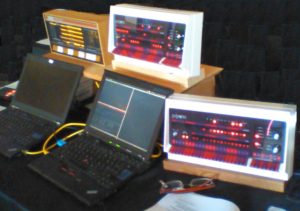I apologize for the pause in blog posts. Between travel and prep’ing the house for sale, the last few weeks have been insane. The painters are wrapping up their work today, leaving a little bit of time for writing.
Our trip took us to the Seattle area for a visit with family. Fortunately, our trip coincided with the 2019 Pacific Northwest Vintage Computer Festival. The festival was held at Living Computers Museum + Labs.
The weather was gloriously spring-like (for a New Englander), making the walk from the Link light rail to the museum a pleasure. The festival took over most of the first floor of Living Computers, including the lab space. If you get the opportunity to attend, I recommend it. There are vintage personal computers, workstations, calculators — all sorts of gear, most of it up and running.
A few highlights…
I had a pleasant chat with Josh Dersch who restored and maintains a Three Rivers Perq workstation. The Perq is one of the first “3 M” machines (1 MIP, 1 MByte, 1 mega-pixel). The Perq originated from the electronics lab associated with the Carnegie-Mellon University Computer Science Department during the mid-70s. I worked at the CS department as a computer operator while grinding my way through C-MU as an undergrad. The electronics lab was a source of many innovative systems: one of the first Xerographic printers (the XGP), a vector display replete with C-MU’s own space war game, and the Perq prototype. The principal players took the Perq commercial in 1974 (just as I was graduating, BTW).
The initial prototype was wire-wrapped. The computer machine room had large glass windows into the electronics lab and I remember watching Brian Rosen as he wrapped and debugged massive prototyping boards stuffed with parts. Josh has one of the original prototype boards. The wire density is staggering. At that scale, one really needed to get things wired right the first time because debugging that rat’s nest of wiring was no fun. (Today’s engineers are spoiled with simulators!)
One of the sweetest systems to combine the new and old is the PiDP-11/70. The PiDP-11/70 combines a Raspberry Pi running simh with a beauty, small-scale PDP-11/70 front panel with all the blinken lights and switches. If the 11/70 is too modern for you, try the PiDP-8/I, which is just as spiffy.
Finally, I quite liked the Gigatron TTL Microcomputer by Marcel van Kervinck and Walter Belgers. I acquired a pile of 7400 series logic components in 1976 with the intention of building my own 16-bit processor with an instruction set architecture (ISA) of my own design. It’s still a pile of parts. Marcel and Walter made this dream into a reality. I spoke with Marcel for several minutes and enjoyed hearing about his approach and design choices.
The Vintage Computer Federation organizes and sponsors Vintage Computer Festivals throughout the United States. Check the schedule and visit one!
Copyright © 2019 Paul J. Drongowski

